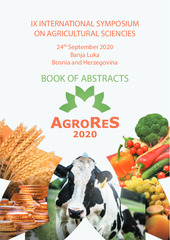Приказ основних података о документу
Maize genetic resources in Serbia – management and utilization in breeding
| dc.creator | Kravić, Natalija | |
| dc.creator | Babić, Vojka | |
| dc.creator | Ristić, Danijela | |
| dc.creator | Stevanović, Milan | |
| dc.creator | Kovinčić, Anika | |
| dc.creator | Anđelković, Violeta | |
| dc.date.accessioned | 2023-12-04T12:51:35Z | |
| dc.date.available | 2023-12-04T12:51:35Z | |
| dc.date.issued | 2020 | |
| dc.identifier.isbn | 978-99938-93-63-9 | |
| dc.identifier.uri | http://rik.mrizp.rs/handle/123456789/1343 | |
| dc.description.abstract | Maize Research Institute „Zemun Polje“ (MRIZP) gene bank preserves ex-situ an active collection (5806 accessions), thus ranking among the five largest European national maize gene bank collections. Local (i.e. western Balkan) maize landraces (2217 accessions) are considered to be the most significant genotypes, since they represent the original biological material created by the process of natural selection and adapted to local growth conditions, thus offering the great opportunities for different breeding purposes and contributing to yield increase. Currently, they are not directly used in breeding, but rather for development of synthetic populations or core collections for the traits of interest, allowing the integration of the most valuable traits (adaptability, variability, divergence and heterotic potential). In the last 15 years, in MRIZP gene bank was conducted identification of superior genotypes regarding specific traits (cytoplasmatic male sterility) and abiotic stress tolerance (herbicides tolerance). In response to more frequent unpredictable and extreme climatic events, as well as to growing demand for healthy food and feed, in MRIZP gene bank were established drought tolerant and improved quality core collections through implementation of long-term pre-breeding programmes, as the most promising way of linking genetic resources and commercial breeding programmes. Moreover, exchange of maize inbred lines from MRIZP gene bank and Agricultural Institute Osijek working collections, genotyping and phenotyping of inbreds, and statistical analysis of molecular and agronomic data, is conducted through ongoing Project “Harmonization of methods for phenotyping, genotyping and management of genetic resources in maize”. Joint analysis of genetic diversity originated from the Western Balkan Corn Belt, along with comparative analysis with the same standards (available genome sequencing data of public lines), will enable the determination of heterotic pattern, removal of possible duplicate and redundant accessions from the collections, contributing to a more efficient management of large inbred lines collections. | sr |
| dc.language.iso | en | sr |
| dc.publisher | Banja Luka : University of Banja Luka, Faculty of Agriculture | sr |
| dc.rights | openAccess | sr |
| dc.rights.uri | https://creativecommons.org/licenses/by/4.0/ | |
| dc.source | 9. international symposium on agricultural sciences - AgroRes 2020 - Book of abstracts | sr |
| dc.subject | core collections | sr |
| dc.subject | gene bank | sr |
| dc.subject | pre-breeding | sr |
| dc.subject | Zea mays L. | sr |
| dc.title | Maize genetic resources in Serbia – management and utilization in breeding | sr |
| dc.type | conferenceObject | sr |
| dc.rights.license | BY | sr |
| dc.citation.spage | 50 | |
| dc.citation.epage | 50 | |
| dc.identifier.fulltext | http://rik.mrizp.rs/bitstream/id/6802/AGRORES-2020-Book-of-Abstracts-50pp..pdf | |
| dc.identifier.rcub | https://hdl.handle.net/21.15107/rcub_rik_1343 | |
| dc.type.version | publishedVersion | sr |


